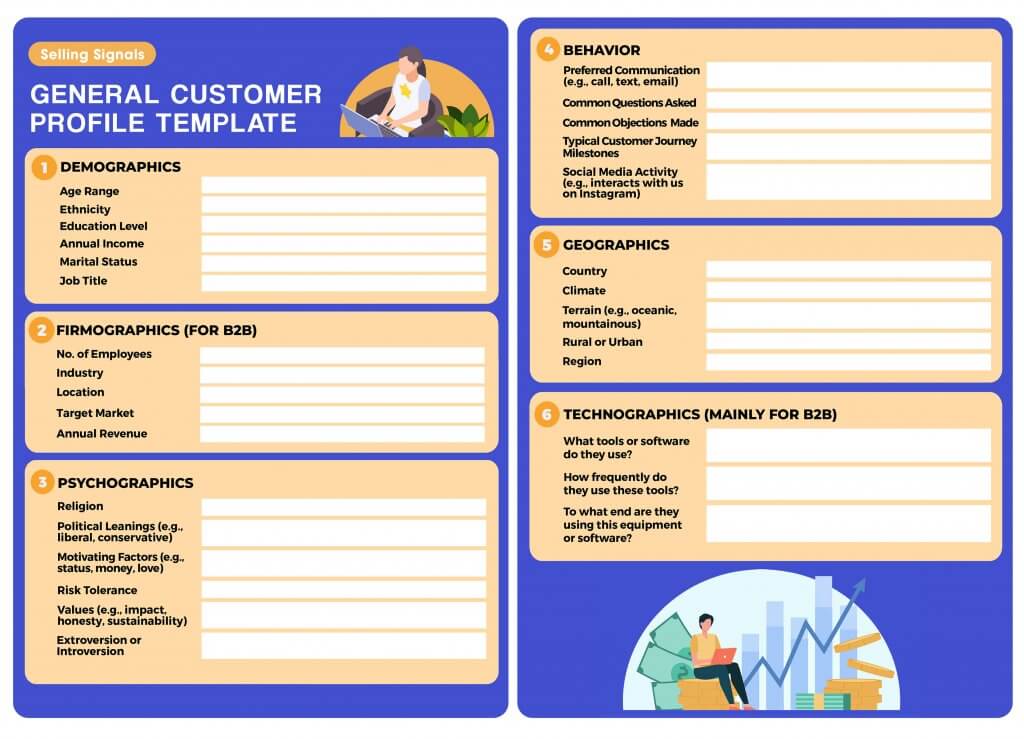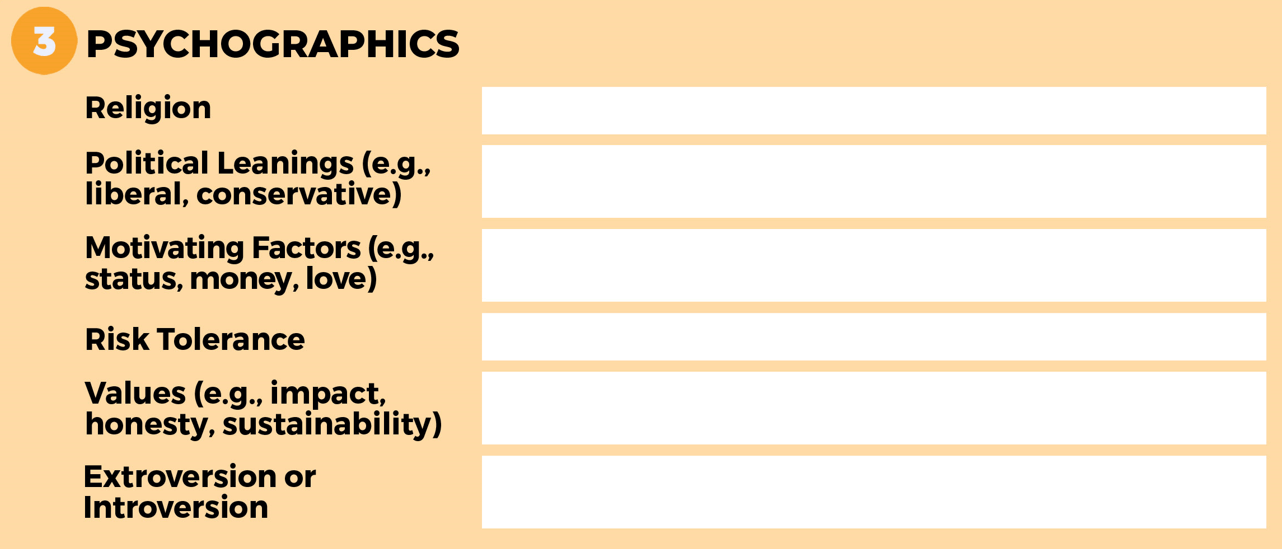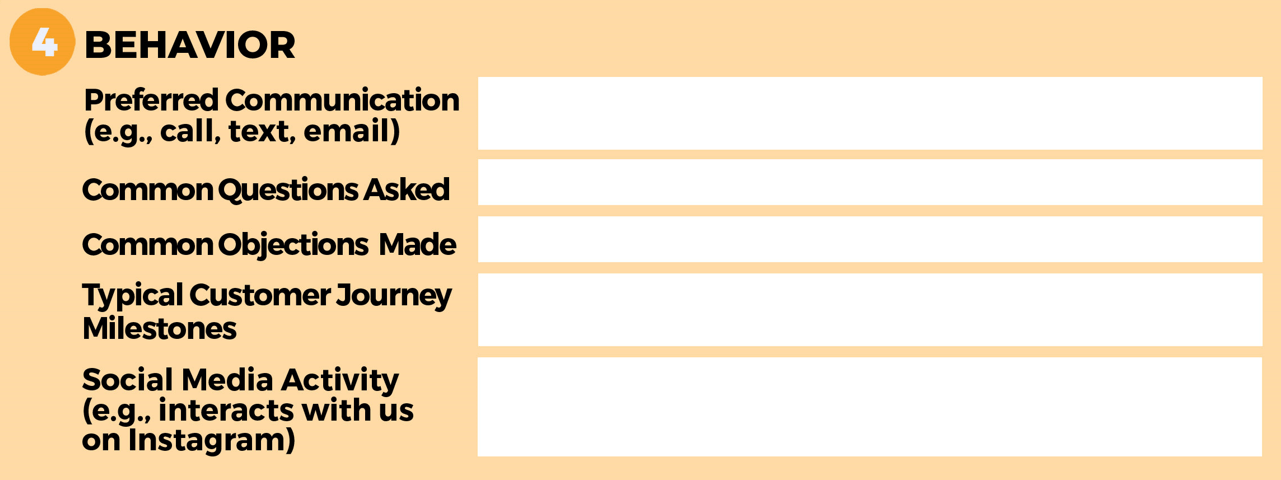-
News & Trends -
Sales -
Marketing Related Topics -
B2B Software Guides Related Topics -
Free Tools & Resources -
- About Us About Us


A customer profile template is a document that prompts you to enter data on your ideal buyer's high-level traits so you can understand them and their needs. These traits could be behaviors, demographics, and/or other key details to know. After filling out the template and identifying your ideal customer, you can fine-tune your sales and marketing verbiage, target the right audience, spot quality leads likely to buy, and create buyer personas to further help you generate and qualify leads.
We created a free customer profile template that any salesperson can use as the foundation of their profile. It includes sections for demographic, psychographic, geographic, and behavioral data. It also has technographic and firmographic sections for B2B sellers, which B2C sellers can remove or leave blank. To use it, interview your customers and analyze your CRM data or conduct market research, then fill in the righthand columns with the most common attributes.

Typically there will be 4–6 sections in a customer profile template, each with its own set of data points to fill in. These sections are typically demographics, firmographics, psychographics, behavior, geographics, and/or technographics, as our free template shows. You might want to add industry-specific sections as well. For example, a healthcare company might add a medical history section. For now, let’s go over each common component.

Demographics consist of socio-economic data points about your customer base, such as age, gender, education, income level, job title, and more. It can be used to understand the causes of customer behavior. Some companies will also segment customers and leads based on demographics to better provide for each group’s specific wants and needs.

Firmographic data consists of the attributes of a company you’d sell to, such as company size, industry, company type, location, revenue, and years in business. Knowing the firmographic data helps you create prospecting lists of similar companies that will likely be interested in using your solution. Businesses with this data often then create a buyer persona defining the people within the company who will purchase the solution.

Pyschographics comprise the motivations, beliefs, values, and attitudes held by your typical customer. This section helps you further understand what influences leads and customers to make purchasing decisions. For example, if your customer base is filled with competitive business owners, an ad about crushing the competition is likely to resonate.

Behavioral data describes how the average customer interacts with your brand and product. Data points include purchase history, social media engagement, email open rates, product usage, and more. This section helps you understand how customers use your solution and respond to your various communication channels and sales and marketing interactions.

Geographic data refers to details like region, city, country, climate, elevation, and other information that informs you about where your typical customer resides. Knowing the geography of your typical customer will help you know where in the world to find other customers. Plus, you’re able to make data-driven decisions about logistics, delivery, and support implementation.

Technographic data details the different technologies and software tools that companies use to run their business, when they acquired them, and how the company uses them. It's most useful for B2B tech companies looking to understand which technologies are often used in tandem with theirs. With this information, they can then search for other companies with a similar tech stack, as they’d likely respond positively to their outreach and product.
A finished customer profile will illuminate nearly everything you need to know about your typical customer to segment your target audience for marketing campaigns and sales outreach. You can then dive deeper and use it to create a more specific, personified buyer persona, which should represent an individual who’d make a great customer.
Different types of companies need to prioritize different data sets when creating their customer profile templates. For example, a B2B company will have a section for firmographic data since it sells to companies, while a B2C company will have no need for this section. Below are eight unique customer profile templates for B2B, B2C, financial services, real estate, software, consulting, health and wellness, and freelance creative sellers.
Who Should Use It: B2B salespeople wanting to understand the makeup of their target companies and the decision-makers to whom they sell their product or service.
Why It Works: This template works because it provides the categories of firmographics so you can define your ideal company to go after and demographics so you know how to spot the decision-makers in those companies. Plus, with the technographics section, you’ll form an understanding of the what, how, and when around the technologies they use to run their business. Finally, psychographics and behavior will help you understand what actions they tend to take and why.
Who Should Use It: B2C salespeople who need to know the demographics, attitudes, behaviors, and geography of their ideal customers to better sell a product or service.
Why It Works: Besides giving you space to write the basic demographic and geographic details of your ideal buyer, this template devotes a lot of space to getting into the mind of your customer with its psychographics section. After filling it out, you’ll understand things like their motivators, beliefs, daily routine, fears, hobbies, and other data points you can play off of in your marketing. In the behavioral section, you can document how to reach them and convince them to buy.
Who Should Use It: Financial advisors, insurance agents, and other financial professionals who sell services to individuals and want to form a profile of their target audience’s socio-economic factors, psychology, and financial data.
Why It Works: This template provides space to write about the ideal customer’s age, income, familial life, and other demographics so you can easily spot and market to them. It then asks for their psychology and behavior, especially related to money, which will help you craft your messaging. After the geographics table, the financial data section helps you understand the ideal customer’s financial situation, investments, etc. so you can better qualify future leads.
Who Should Use It: Real estate agents and realtors looking to understand the demographics, psychographics, behavior, geographic data, and housing preferences of their target customers.
Why It Works: This template gives you space to write about the preferences of your ideal customer in terms of the style and location of the house. It also covers the basic sections like demographics and behavior while also prompting you to document the homeownership or rental history of your target buyers.
Who Should Use It: B2B software or SaaS salespeople particularly interested in uncovering their target audience’s firmographics and technological makeup so they can better sell their product.
Why It Works: This template is perfect for software salespeople because of its emphasis on finding data surrounding the software ideal companies used before they bought your tool and currently use alongside it. It also helps you understand their attitudes and comfortability when it comes to technology. After creating this profile, reps should easily be able to find and connect with decision-makers within ideal companies.
Who Should Use It: B2B consultants wanting to know the demographics, psychographics, and financial data of their ideal companies.
Why It Works: This template’s firmographic section includes a lot of financial fields that enable B2B consultants to input information like revenue, costs, YoY growth, and other relevant numbers of their common clients. With this intel plus the other included sections, consultants can identify businesses they believe they can help and more easily sell their services to them.
Who Should Use It: Nutritionists, physicians, supplement salespeople, and other health-related professionals looking to form a profile of their ideal customer’s health and medical history. It works for both services and products.
Why It Works: This template provides salespeople with a full snapshot of a person’s health. It includes fields like their work history, activity levels, age, chronic issues, diet, BMI, and more. Plus, it helps you make sense of the mind of your most common buyer. Perhaps they’re tired of medications or averse to alternative medicine. After filling out this template, you’ll be able to better qualify and market to potential leads.
Who Should Use It: Freelance writers, designers, editors, filmmakers, and other creatives trying to identify their ideal companies and decision-makers to whom they can sell their services.
Why It Works: This template is effective because it focuses on finding the average relationship between a freelancer and the company, taking into account communication styles, revision needs, the knowledge of the decision-maker, and other factors that can help a freelancer determine if the relationship will work out. It also includes firmographic and demographic sections so freelancers can find ideal companies and their decision-makers.
Feel free to mix and match these examples or use them as inspiration to create your own customer profile template sections and prompts. Ultimately, your template should ask for the information that will help you best understand your current or ideal customers.
You can either create your customer profile template from scratch or modify an existing template to fit your specific business needs. Regardless, there are some best practices you should follow to make it easy to fill out and as useful as possible. These tips include using examples for clarity, surveying your customers to find out what they have in common, regularly updating your template, and adding sections specifically related to your business or industry:
If you follow these tips, you’ll create top-notch customer profiles that you can use to qualify leads, find new buyers, intelligently update your products and services, and personalize marketing campaigns and sales outreach to different segments of your market. Once you’ve nailed your customer profile, you can use a buyer persona template to further understand your audience. All this will help you generate more profitable leads and maintain your current customers.
Customer profile templates are documents that tell you which data points you need to fill in to create a data-backed profile of a segment of your customers. Data points often include traits related to demographics, psychographics, behavior, geography, and, in the case of B2B companies, technographics and firmographics. To learn how to create and fill in your own customer profiles, read our article that walks you step by step through building a customer profile.


Sam is a former SaaS sales rep turned freelance writer. He spent his career selling real estate technology to C-suite executives before switching over to blogging, where he now covers sales, marketing, and small business topics. Sam specializes in lead generation, lead nurturing, and deal closing articles for Selling Signals. When he’s not researching the latest sales trends, he’s either penning short stories, hiking, or reading in NYC’s Washington Square Park.

Selling Signals delivers actionable advice for sales and marketing professionals. Learn strategies that help you hit targets, strengthen customer relationships, and win more business. Get expert advice on lead generation, sales processes, CRM software, sales management, and account management directly to your inbox.
Property of TechnologyAdvice. © 2025 TechnologyAdvice. All Rights Reserved
Advertiser Disclosure: Some of the products that appear on this site are from companies from which TechnologyAdvice receives compensation. This compensation may impact how and where products appear on this site including, for example, the order in which they appear. TechnologyAdvice does not include all companies or all types of products available in the marketplace.